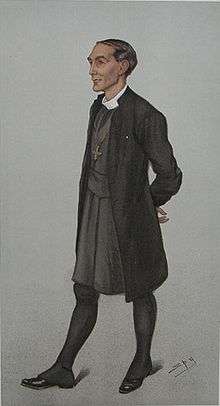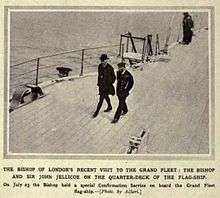Arthur Winnington-Ingram
| The Right Reverend Arthur Winnington-Ingram | |
|---|---|
| Bishop of London | |
 Arthur Winnington-Ingram shortly after his appointment as Bishop of London in 1901 | |
| Diocese | Diocese of London |
| Elected | 17 April 1901 (confirmed)[1] |
| Term ended | 1 September 1939 (retired)[2] |
| Predecessor | Mandell Creighton |
| Successor | Geoffrey Fisher |
| Other posts |
Bishop of Stepney 1897–1901 |
| Orders | |
| Ordination | Geoffrey Fisher |
| Consecration | 30 November 1897[3] |
| Personal details | |
| Born |
26 January 1858 Stanford-on-Teme, Worcestershire, United Kingdom |
| Died |
26 May 1946 (aged 88) Upton-upon-Severn, Worcestershire, United Kingdom |
| Nationality | British |
| Denomination | Anglican |
| Parents | Edward Winnington-Ingram and Louisa Pepys |
| Alma mater | Keble College, Oxford |


Arthur Foley Winnington-Ingram KCVO PC (26 January 1858 – 26 May 1946) was Bishop of London from 1901 to 1939.
Early life and career
He was born in the rectory at Stanford-on-Teme, Worcestershire, the fourth son of Edward Winnington-Ingram (a Church of England priest and Rector of Stanford) and of Louisa (daughter of Henry Pepys, Bishop of Worcester).[4] Winnington-Ingram was educated at Marlborough College and Keble College, Oxford; he graduated with second-class honours in Literae Humaniores ('Greats') in 1881.[5] His younger brother Edward and his nephew (Edward's son) Arthur were both priests who became Archdeacons of Hereford.[6] Another nephew of his was Reginald Pepys Winnington-Ingram, an important scholar of Greek tragedy and Professor of Greek at King's College, London.[7]
He was a private tutor in Europe,[8] 1881–84; curate at St Mary's, Shrewsbury, 1884–85; private chaplain to the Bishop of Lichfield, 1885–89; head of Oxford House Settlement, Bethnal Green 1889–97,[9] chaplain to the Archbishop of York, 1889; rector of Bethnal Green, 1895; rural dean of Spitalfields, 1896; and canon of St Paul's Cathedral, 1897.
Episcopal career
In 1897, Winnington-Ingram was raised to the episcopate as the second suffragan Bishop of Stepney.[10] In 1901, after the death of Mandell Creighton, he was nominated to the See of London,[11] and he was in the same year appointed as a Privy Counsellor.[12] As a preacher he proved very successful. He was a leader in social work in London's East End. As an administrator he has been judged inefficient in maintaining standards among the clergy in comparison with his disciplinarian-minded successor Geoffrey Fisher, a feature aggravated by his lengthy tenure.
World War I
During World War I Winnington-Ingram threw himself into supporting the war effort. He saw the war as a ‘great crusade to defend the weak against the strong’ and accepted uncritically stories of German atrocities. For a clergyman the language he used about the German people verged on xenophobia and H. H. Asquith, Prime Minister at the outbreak of the war, described his pitch as "jingoism of the shallowest kind." He spoke in aid of recruiting drives and later in the war urged his younger clergy to consider enlisting as combatants. Chaplain from 1901 to the London Rifle Brigade and London Royal Naval Volunteers, he visited the troops on both the Western Front and at Salonika and the Grand Fleet at Rosyth and Scapa Flow.[13]
For his war work he was Mentioned in Despatches and awarded the Grand Cross of the Order of the Redeemer (Greece) and the Order of St. Sava, 1st Class (Serbia).
Later life and legacy
On 22 May 1946, Winnington-Ingram was taken ill while playing golf and he died a few days later on 26 May 1946 in Upton-upon-Severn, Worcestershire.[14] His remains were buried at St Paul's Cathedral.[15] He never married, although while Bishop of Stepney he was briefly engaged[16] to Lady Ulrica Duncombe, a friend of Queen Alexandra and daughter of William Ernest Duncombe, 1st Earl of Feversham of Ryedale and Mabel Violet Graham.
Australian sculptor Theodora Cowan created a portrait bust of Dr Winnington-Ingram which "took pride of place" in her one-woman show at London's Grafton Galleries.[17][18]
He is commemorated in some of the street names in Hampstead Garden Suburb: The Bishops Avenue, Winnington Road and Ingram Avenue; and Bishop Winnington-Ingram Primary School, Ruislip.[19]
Works
Unless otherwise indicated, all titles sourced from his sketch in Crockford's Clerical Directory 1938:
- Old Testament Difficulties (1890)
- New Testament Difficulties (1892)
- Church Difficulties (1893)
- Work in Great Cities (1895)
- Messengers, Watchmen, Stewards (1896)
- The Men Who Crucified Christ (1896)
- Friends of the Master (1897)
- Banners of the Christian Faith (1899)
- Popular Objections to Christianity (1899)
- The Afterglow of a Great Reign (1901)
- Under the Dome (1902)
- Addresses in Holy Week (1902)
- Faith of Church and Nation (1904)
- Lenten Addresses (1905)
- The Gospel in Action (1906)
- A mission of the Spirit (1906)
- The Call of the Father (1907)
- The Love of the Trinity (1908)
- Joy in God(1909)
- Into the Fighting Line (1909)
- The Mysteries of God (1910)
- Secrets of Strength (1911)
- The Attractiveness of Goodness (1913)
- The Gospel of the Miraculous (1913)
- A Day of God (1914)
- The Eyes of Flames (1914)
- The Church in time of war (1915)
- The Potter and the Clay (1917)
- Rays of Dawn (1918)
- Victory and After (1919)
- Spirit of Peace (1921)[20]
- Rebuilding the Walls (1922)
- The Spirit of Jesus (1925)
- The Sword of Goliath (1926)
- Some World Problems (1927)
- Holiday Recollections of a World Tour (1928)
- Why am I a Christian? (1929)
- Good News from God (1930)
- What the Cross Means to Me (1934)
- Has God spoken to man? (1934)
- Has the Kingdom of God Arrived? (1935)
- Nine Christian Virtues (1936)
- Every Man's Problems and Difficulties (1937)
- What a Layman Should Believe (1938)
- The Secrets of Happiness (1939)[21]
- Fifty Years' Work in London (1940)[21]
- Secrets of Fortitude (1940)[21]
References
- ↑ The Tablet archive — 20 April 1901, pages 24–25 (Accessed 2 July 2015)
- ↑ "Church news (Archived; subscription only)". Church Times (#3997). 1 September 1939. p. 199. ISSN 0009-658X. Retrieved 2 July 2015. (subscription required (help)).
- ↑ Oxford DNB — Ingram, Arthur Foley Winnington- (Accessed 2 July 2015)
- ↑ Thicknesse, Cuthbert (1959). Wickham Legg, LG; Williams, ET, eds. Dictionary of National Biography, 1941–1950. Oxford University Press. p. 964.
- ↑ Oxford University Calendar 1895, Oxford : Clarendon Press, 1895, p.232.
- ↑ Winnington-Ingram, Ven. Arthur John. Who Was Who. 1920–2008 (December 2007 online ed.). A & C Black, an imprint of Bloomsbury Publishing plc. Retrieved 4 June 2013.
- ↑ http://www.thepeerage.com/p25721.htm#i257208
- ↑ Dictionary of National Biography, 1941–1950. p. 965.
- ↑ History, Oxford House.
- ↑ Who's Who, 1901
- ↑ The London Gazette: no. 27295. p. 1937. 19 March 1901.
- ↑ The London Gazette: no. 27313. p. 3273. 14 May 1901.
- ↑ Oxford Dictionary of National Biography, Volume 29. Oxford University Press. 2004. p. 281. ISBN 0-19-861379-2.Article by Jeremy Morris.
- ↑ "Dr AF Winnington-Ingram". Obituaries. The Times (50462). London. 27 May 1946. col D, p. 6.
- ↑ Oxford Dictionary of National Biography, Volume 29. p. 282.
- ↑ "Winnington Ingram". Auckland Star. XXXII (111). 11 May 1901. p. 5.
- ↑ Prior, James (11 December 1985). "Theodora Cowan - Chipping away at a career ... and sexism". The Sun (Sydney). p. 49.
- ↑ Sturgeon, Graeme (1978). The Development of Australian Sculpture 1788-1975. London: Thames and Hudson. p. 48.
- ↑ Bishop Winnington-Ingram Primary School website
- ↑ Who Was Who, 1941-1950. A and C Black. 1952. p. 588.
- 1 2 3 Who Was Who, 1941-1950. p. 589.
- Spencer Cecil Carpenter, Winnington-Ingram. The biography of Arthur Foley Winnington-Ingram, Bishop of London, 1901-1939 (1949)
- Percy Colson, Life of the Bishop of London: An Authorised Biography; A Tribute on His Jubilee 1885-1935 (1935)
External links
| Wikimedia Commons has media related to Arthur Winnington-Ingram. |
- Works by Arthur Foley Winnington Ingram at Project Gutenberg
- Works by or about Arthur Winnington-Ingram at Internet Archive
- Works by Arthur Winnington-Ingram at LibriVox (public domain audiobooks)

- Bibliographic directory from Project Canterbury
- DNB entry
| Church of England titles | ||
|---|---|---|
| Preceded by Forrest Browne |
Bishop of Stepney 1897–1901 |
Succeeded by Cosmo Lang |
| Preceded by Mandell Creighton |
Bishop of London 1901–1939 |
Succeeded by Geoffrey Fisher |